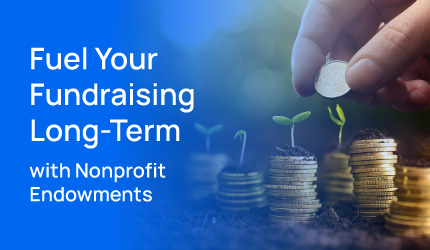
If your nonprofit’s team is facing fundraising burnout, you’re likely looking for low-lift fundraising opportunities that don’t require as much time or effort to secure necessary funding. A quick, simple fundraiser might provide some relief in the short term, but why not look for solutions that can boost your nonprofit’s revenue and save team time long-term?
That’s where endowments come in. By creating an endowment or accepting endowment gifts from high-capacity donors, you can set your nonprofit up for growth and greater financial sustainability—all without extensive effort. In this guide, we’ll explore how nonprofit endowments work and what steps to take to start fueling your long-term fundraising success.
What are nonprofit endowments?
According to NXUnite, a nonprofit endowment is “a pool of donations set aside and invested, which allows it to grow and financially support the work of a philanthropic organization.”
Endowments begin with a principal investment (typically a donation or fund transfer) which is meant to grow over time. As the fund grows, your nonprofit “pays out” a certain percentage of the investment income each year (known as an annual distribution) and uses it to fund your work. This way, while most of the money in the fund remains set aside and grows over time, your nonprofit also has a predictable source of income each year.
Nonprofits can create their own endowments and invite donors to contribute, or individual donors and families can donate micro-endowments to a nonprofit directly. Donors may place restrictions on their endowment gifts, limiting how you can spend the earnings. However, unrestricted endowments are often easier to manage and generate more overall impact.
Endowment benefits for nonprofits and donors
All types of endowments can provide a wealth of long-term benefits for your organization, including:
- Potential for the funds to grow. With low-risk investment strategies, the original donation can grow significantly through the years without asking more from the donor.
- Easier long-term financial planning. Your endowments will have standard annual disbursement amounts, such as 5% of the total funds, providing consistent funding you can count on every year.
- More sustainable, low-lift fundraising. Partnering with the right investment advisor can simplify endowment maintenance. Once your endowments are set up, all you have to do is monitor their growth and handle distributions.
Donors who give endowment gifts get plenty of benefits, too. They can make a greater impact on your nonprofit both during and beyond their lifetimes by investing their original gift, helping them leave a lasting legacy in their name. Plus, donors receive immediate tax benefits whenever they add to the endowment, whether through stock giving, wills, or additional cash gifts.
Ultimately, endowments help both nonprofits and donors form deeper, more meaningful relationships long-term while providing a sustainable source of funding.
How to create an endowment and accept endowment gifts
Ready to start boosting your financial sustainability with endowments? Take these steps to start accepting endowment gifts for your nonprofit:
1. Partner with a nonprofit investment advisor.
The first step is to choose a nonprofit investment advisor to work with. While some nonprofits decide to work with larger banks or investment firms, these institutions don’t have nonprofit expertise and therefore may not understand your organization’s needs and goals.
A qualified nonprofit investment advisor, on the other hand, will have years of both financial and nonprofit industry experience under their belt. They’ll help you write an Investment Policy Statement (IPS), create your endowment, and manage it based on your desired investment strategies and specifications. As you research your options, look for an advisor with low fees, demonstrated nonprofit experience, and expert investment portfolio management services.
Once you’ve made a decision, meet with your new advisor to discuss your endowment goals. One of the first actions they’ll take is to open a brokerage account for your organization, which allows you to invest money and accept stock donations from donors. Your investment advisor will help you open this account and guide you through the entire endowment creation and management process.
2. Decide how to structure your endowment.
Next, work with your investment advisor to determine the best way to structure your new endowment. According to Infinite Giving’s nonprofit endowment guide, you can choose from three main types of endowments:
- True endowments: These endowments hold your principal investment in perpetuity, only giving you access to allocate and spend the investment earnings. This type of endowment isn’t ideal for most nonprofits, since they’re typically highly restricted.
- Term endowments: Term endowments only exist for a specific period of time, then they expire. After a term endowment’s expiration, you can use both the principal and its investment earnings without restriction.
- Quasi endowments: These endowments can be created and dissolved by your organization’s board at any time, giving you much more flexibility in terms of financial planning and using the funds.
No matter which option you choose, you’ll need to create an Endowment Agreement, an important legal document that guides your investment strategies, disbursements, and the usage of your endowment funding. Your Endowment Agreement could be part of your IPS, but it’s typically added as an addendum to your IPS as a separate agreement.
This agreement includes information about the purpose of your endowment, the annual disbursement amount, investment strategies, and usage guidelines. Work with your advisor to iron out these details, and listen to their advice about the best strategies that will align with your endowment goals and generate long-term growth.
After you create the endowment, you can start investing the funds based on your chosen risk levels and investment strategies. Your nonprofit investment advisor should help you easily track the progress of your investments and communicate how the endowment grows over time.
3. Promote the opportunity to interested donors.
With the infrastructure covered, you can start marketing your new giving option to donors. Start by creating a page on your nonprofit’s website or adding a new section about your endowment to your Ways to Give page. Explain what endowments are, how they work, and why they’re beneficial for both donors and your nonprofit. Then, provide the contact information of someone interested donors can reach out to for more information.
Share this page by posting on social media, sending out an email blast, or writing a blog post to announce your new endowment and encourage donors to fund it with their gifts.
Along with general promotion, reach out personally to donors who may be interested in endowment giving based on their giving habits, demographics, and prospect research data. For example, someone who expressed interest in planned giving in the past but has since been a recurring mid-level donor might be excited to learn about an easier way to make a lasting impact during their lifetime.
4. Thank and update endowment donors.
Once you receive an endowment donation, it’s crucial to thank the donor and recognize their contribution in multiple ways. An endowment is a major gift—meaning these donors deserve your full attention. Consider recognizing them with:
- Personal phone calls from a major gifts officer, founder, or board member.
- A handwritten thank-you note signed by your nonprofit’s leaders.
- Invitations to in-person appreciation events where you can celebrate their generosity.
- A place on your donor recognition wall or plaque.
Additionally, it’s important to keep donors updated on the status of their endowment gifts, the fund’s growth, and how you use the disbursements to further your mission. Provide them with regular updates and personalized impact reports to show them how much their contributions will help your nonprofit long term.
Some endowment management platforms also come with intuitive dashboards for donors to simplify this process and promote transparency. By visiting these dashboards, endowment donors can see the progress of their endowment’s growth in real time and rest assured that they’re up to date.
The Bottom Line
Nonprofit endowments are impactful long-term revenue sources that shouldn’t be limited to only the largest organizations. With the right tools, support, and knowledge, any organization can start accepting endowment gifts and fuel their fundraising efforts.
About the Author
 Karen Houghton is the CEO of Infinite Giving, a relationship and technology driven Nonprofit Investment Advisor. Karen leverages her deep nonprofit expertise to bring a modern and curated investment experience to nonprofit organizations all over the US. She advocates for organizational sustainability through better financial management, strategic access to curated investment practices for reduced management fees, and increased asset giving.
Karen Houghton is the CEO of Infinite Giving, a relationship and technology driven Nonprofit Investment Advisor. Karen leverages her deep nonprofit expertise to bring a modern and curated investment experience to nonprofit organizations all over the US. She advocates for organizational sustainability through better financial management, strategic access to curated investment practices for reduced management fees, and increased asset giving.





